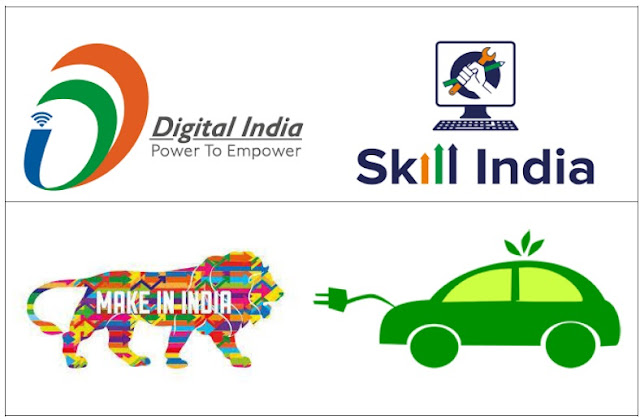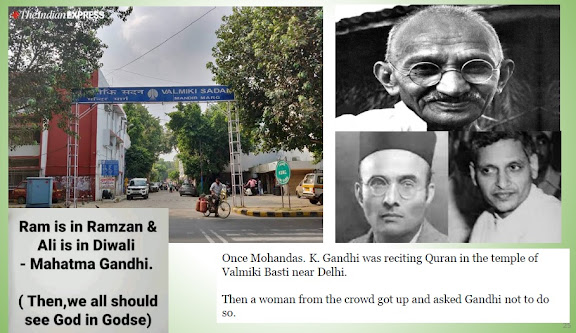India on the Development Path under Modi Government
‘Instead of giving the people Fish,
Teach them Fishing’ may be good for any political leader with a vision, but not
to those who wanted to encash on the short term
goal.
Laying a strong foundation to
improve India’s Infrastructure and to reap its benefits may take a long time –
but still Modi Government had shown to the world
that Development has been well founded and also well received by the public at
large to a very great extent.
Here a few recent
development measures undertaken are listed.
Ujjwala revolution:
Pradhan Mantri Ujjwala Yojana (PMUY) is a welfare scheme being implemented by the Ministry of Petroleum
and Natural Gas to provide LPG connections to families below the poverty line,
guided by the strong commitment to bring about changes in the life of poor
women and also protect their health. The beneficiaries (adult woman of a BPL
family) as identified by Socio-Economic Caste Census (SECC) is given a deposit
free LPG connection with a financial assistance of Rs.1600 per connection by
the centre. This scheme will help prevent pollution and facilitate the healthy
atmosphere in the families of poor people.
Last month, the Pradhan Mantri Ujjwala Yojana (PMUY) completed two
years of operation. During this time the number of LPG connections has crossed
4 crore, and LPG penetration
in India has risen from 56% in 2014 to 80%. While distributing new connections
is no mean feat, the greater challenge for the mission lies in refills.
The usage pattern of PMUY customers who have been in the
system for a year or more is quite revealing, as they have been buying four or
more cylinders a year. Data from the Indian Oil Corporation Limited (IOCL),
which has given out almost half of the Ujjwala connections, suggest that between May 2016 and April
2017, IOCL enrolled 85.47 lakh Ujjwala customers. From May
2016 to April 2018, the average cylinder consumption of these customers was 4.4
per year, including the installation cylinder.
In order to bring all poor village folks to avail this
facility, a peer learning platform: the Pradhan Mantri LPG Panchayat is also functioning.
By sharing the vision of early adopters and ironing out service issues, the LPG
Panchayats being held at
village levels across India are helping more and more people appreciate the
advantages of clean fuel.
The adoption of LPG has received a boost with supplies
ramping up and service improving. In April 2014, there were 13,896 LPG
distributors across India. This number is now 20,227. Another 3,750
distributorships will be commissioned in 2018-19.
Days
of getting gas connections being reserved to a selected few wherein poor had no
chance of getting the connections are all the things of the past and now, poor
rural folks are getting gas connections at their door steps with deposit free
and also with financial assistance of Rs.1600 per connection. Solar Power in India
Solar power in India is growing very
fast and the country's solar installed capacity reached 20 GW in February
2018. India expanded its solar-generation capacity 8 times from 2,650 MW
on 26 May 2014 to over 20 GW as on 31 January 2018. The 20 GW capacity was
initially targeted for 2022 but the government achieved the target four years
ahead of schedule.
In addition to its large-scale grid-connected solar PV
initiative, India is developing off-grid solar power for local energy needs.
Solar products have increasingly helped to meet rural needs; by the end of 2015
just under one million solar lanterns were sold in the country,
reducing the need for kerosene. That year, 118,700 solar home lighting
systems were installed and 46,655 solar street lighting installations were
provided under a national program; just over 1.4 million solar
cookers were distributed in India.
Apart from Solar Parks to harness solar energy to
generate electricity in a big way, Solar Train, Solar Bus, Solar Car had become
realities in Modi’s 4 + years rule under
Modi’s Make in India
Scheme.
The following visuals will speak by
themselves:
India’s first solar-powered DEMU
train
Short Note: While the 1,600
horsepower train has been manufactured at the Integral Coach Factory (ICF) in
Chennai, its solar system and panels have been developed and fitted by the
Indian Railways Organization of Alternative Fuel (IROAF).
The IROAF has developed this system
with a smart inverter, which optimises power generation on a moving train to cater to full load
even during night hours with the help of a battery bank that ensures sufficient
electricity. The system reduces diesel consumption and the carbon signature of
these commuter trains by reducing carbon dioxide generation by 9 tonnes per coach per year.
A solar-powered DEMU train with six
trailer coaches will save about 21,000 litres of diesel,
thereby saving ₹12 lakh every year, the Railways added.
Electric Bus:
25 ‘Made in India’ Tata Starbus Hybrid electric buses delivered in
Maharashtra
Short Note:
The new Tata Starbus Hybrid Electric Bus runs on dual
power viz diesel and electric and is hence, economically viable, safe and
environmentally friendly. The vehicle also complies with all UBS-II (Urban Bus
Specifications) and has a BS-IV compliant engine.
Mumbaikars can experience the first ‘Made in
India’ Hybrid Buses on the Bandra Kurla Complex route in the city.
Rajasthan
Rajasthan is known as most solar
developed state of India and also home to the worlds largest Fresnel type plant
in Dhirubhai Ambani Solar Park along with Bhadla Solar Park in
Jodhpur district as well as solar park in Jaisalmer and Bikaner. Jaisalmer also has one of the largest
wind farm in India.
Karnataka:
When completed, the Pavagada solar park in southern India is
expected to generate 2,000 megawatts of electricity, making it the world's
largest solar station. (Karnataka Solar Power Development Corp.)
Indian Prime Minister Narendra Modi and French
President Emmanuel Macron visited a solar power plant in Mirzapur, India, in March 12, 2018.
Passengers’ Facilities at Railways are improved many fold in respect of catering,
booking, wifi at stations, cleanliness in stations and trains, attending to customers’ complaints while on travels etc. Apart from these, Chetan Bhagat, famous writer, has found Indian Railways best train and in particular, he
appreciated Anubhuti Coach of Ahmedabad-Mumbai Shatabdi Express and had gone to the extent of extolling people to ditch the plane
ride for train travel!
There are many more developmental
activities – the most two ambitious being ‘Housing to All’, ‘Health Insurance
Cover to all’, while ‘Electricity to all’ has been achieved. Hence voters
should not heed to the anti-Modi Tukde-Tukde gangs spreading Anti-Hindu Sentiments and Pro-Pakistani
propaganda and Most Prejudiced Views on news on developments happening in India
– apart from siding with Muslims/Christians even if they were terribly at fault.
Time has come for Hindus to realize
these realities and act in unison in voting Modi in 2019. After
all, we say: Modi has done a lot for Bharath during his first term – Let Modi be given another term to complete his mission of Developed India.
Think
India Think.












Comments